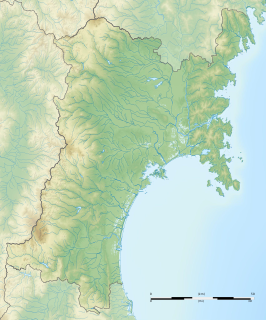 W
WAkahogi Tile Kiln site is the remains of a late Nara period, early Heian period roof tile and pottery production site located in what is now the city of Takayama, Gifu Prefecture in the Chūbu region of Japan. It has been protected by the central government as a National Historic Site since 1976.
 W
WThe Atsumi Kiln is a generic name for a historic kiln that dates back from the late Heian period to the Kamakura period. It was located on the Atsumi Peninsula in Aichi prefecture.
 W
WThe Daikichiyama Tile Kiln ruin is an archaeological site with the remains of a late Nara period to early Heian period roof tile production site located in what is now the city of Ōsaki, Miyagi Prefecture in the Tōhoku region of northern Japan. It has been protected by the central government as a National Historic Site since 1976.
 W
WThe Dodo Sue Ware Kiln Site is an archaeological site containing late Heian to early Kamakura period kilns located in what is now part of the city of Tahara, Aichi in the Tōkai region of Japan. The site was designated as a National Historic Site by the Japanese government in 1922.
 W
WThe Goshogawara Sue Pottery Kiln Site is an archaeological site consisting of the remains of Heian period kilns located in what is now the city of Goshogawara, Aomori Prefecture in the Tōhoku region of northern Japan. It is protected by the central government as a National Historic Site.
 W
WHinodeyama Tile Kiln ruins is an archaeological site consisting of the remains of seven Nara period kilns located in what is now the town of Shikama, Miyagi Prefecture in the Tōhoku region of northern Japan. It has been protected by the central government as a National Historic Site since 1976.
 W
WThe Irago Tōdai-ji Tile Kiln ruins is an archaeological site containing the remnants of a number of Anagama kilns, from which the roof tiles for the Kamakura period reconstruction of the temple of Tōdai-ji in Nara were made. The site is located in what is now part of the city of Tahara, Aichi Prefecture in the Tōkai region of Japan. It was designated a National Historic Site of Japan in 1967.
 W
WKido Tile Kiln site is an archaeological site with the remains of a late Nara period, early Heian period kiln for roof tile production located in what is now the city of Ōsaki, Miyagi Prefecture in the Tōhoku region of northern Japan. It has been protected by the central government as a National Historic Site since 1976.
 W
WThe Konagasō kiln ruins is an archaeological site containing a Muromachi period kiln located in what is now part of the city of Seto, Aichi in the Tōkai region of Japan. The site was designated a National Historic Site of Japan in 1971.and was expanded in 2002.
 W
WKosugimaruyama Site is an archaeological site with the ruins of a late Asuka period pottery production site located in what is now the city of Imizu, Toyama Prefecture in the Hokuriku region of Japan. It has been protected by the central government as a National Historic Site since 1990.
 W
WMotoyashiki Pottery Kiln Site is an archaeological site containing late Sengoku to early Edo period kilns located in what is now part of the city of Toki, Gifu in the Chubu region of Japan. The site was designated a National Historic Site of Japan in 1967. Many of the pottery shards excavated from this site have been collectively designated as National Treasures or National Important Cultural Property of Japan.
 W
WThe Ōarako Old Kiln Site is an archaeological site containing the ruins of five noborigama kilns located in what is now part of the city of Tahara, Aichi in the Tōkai region of Japan. The kilns were built in the late Heian period and were in use into the Kamakura period The site was designated a National Historic Site of Japan in 1971.
 W
WOibora-Asakura Sue Ware Kiln Site is an archaeological site containing la group of Nara period kilns located in what is now part of the city of Gifu in the Chubu region of Japan. The site was designated a National Historic Site of Japan in 1979.
 W
WThe Otomefudōhara Tile Kiln ruins is an archaeological site with the ruins of an early Nara period kiln, located in the city of Oyama, Tochigi Prefecture in the northern Kantō region of Japan. It was designated a National Historic Site of Japan in 1978.
 W
WThe Sanage Kiln is a generic name for a historic kiln dating back over 1,000 years. It is located about 20 km west of Toyota in the east of Aichi prefecture.
 W
WSuzu ware is a type of pre-modern Japanese pottery from the Noto Peninsula on the coast of Ishikawa prefecture, in the Hokuriku region of central Japan.